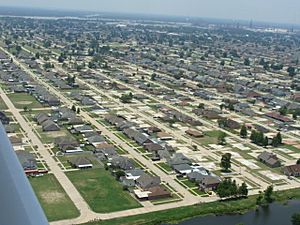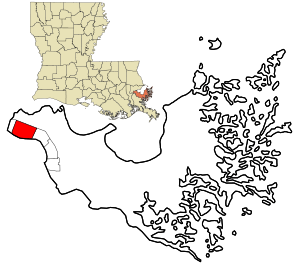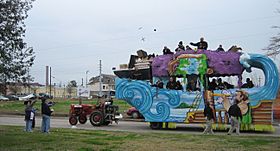Chalmette, Louisiana facts for kids
Quick facts for kids
Chalmette, Louisiana
|
|
|---|---|

View of Chalmette residential area
|
|

Location in St. Bernard Parish and the state of Louisiana.
|
|
| Country | United States |
| State | Louisiana |
| Parish | St. Bernard |
| Area | |
| • Total | 7.96 sq mi (20.63 km2) |
| • Land | 7.17 sq mi (18.58 km2) |
| • Water | 0.79 sq mi (2.04 km2) |
| Elevation | 3 ft (0.9 m) |
| Population
(2020)
|
|
| • Total | 21,562 |
| • Density | 3,005.58/sq mi (1,160.38/km2) |
| Time zone | UTC-6 (CST) |
| • Summer (DST) | UTC-5 (CDT) |
| ZIP Codes |
70043, 70044
|
| Area code(s) | 504 |
| FIPS code | 22-14135 |
Chalmette (pronounced shal-MET) is a community in southeastern Louisiana, United States. It is the main town and "parish seat" of St. Bernard Parish. A parish seat is like a county seat, where the local government offices are. Chalmette is also a "census-designated place" (CDP), which means it's an area identified by the U.S. Census Bureau for statistical purposes.
In 2000, Chalmette had over 32,000 people. After Hurricane Katrina in 2005, the population dropped to about 16,751 by 2010. However, by 2020, it had grown back to 21,562 people. Chalmette is located just east of downtown New Orleans.
The community gets its name from Louis-Xavier Martin de Lino de Chalmette, who owned a plantation here. The word "Chalmette" in French means "pasture" or "fallow land," which is land left unplanted for a time.
Contents
History of Chalmette
Chalmette was first settled by Louis-Xavier Martin de Lino de Chalmette, a plantation owner from Quebec. His family had strong ties to the area.
The Battle of New Orleans
A very important event in American history happened in Chalmette. In January 1815, the famous Battle of New Orleans took place on the Chalmette plantation. This battle was fought between American forces, led by Major General Andrew Jackson, and British forces. The Americans won this major battle. During the fight, Andrew Jackson ordered the Chalmette plantation to be completely destroyed. This was done to stop the British from using it as a hiding place.
Today, the battlefield is a special national monument. It has a visitor center where you can learn about the battle. The Chalmette National Cemetery is also nearby. Since the 1970s, this site has been part of the Jean Lafitte National Historical Park and Preserve. This park has several locations, and its main office is in the French Quarter of New Orleans.
Next to the battlefield, you can see the Malus-Beauregard House. This plantation house was built in 1830 and is open for visitors to explore. From 1951 to 1983, Chalmette was also home to a large Kaiser Aluminum factory.
Hurricane Katrina's Impact
On August 29, 2005, Hurricane Katrina caused a huge storm surge in Chalmette. A storm surge is a rise in sea level caused by a storm. The water, as high as 14 to 15 feet (about 4.9 meters) in some areas, flooded most of the town. This happened because of the Mississippi River–Gulf Outlet Canal, a channel dug in the 1960s. Chalmette was severely damaged and destroyed. Most people had left before the storm, but some lives were still lost.
After the hurricane, many buildings were too damaged to be saved. There were also concerns about a large oil spill from the Murphy Oil facility in Chalmette. A huge oil tank was knocked over by the floodwaters.
The community worked hard to rebuild. The local government offices became a temporary home for many workers helping with the recovery. A year later, people were still working day and night to bring the community back. The church of Our Lady of Prompt Succor became a central place for help and even held funerals for a year after the storm.
Many people lived in temporary trailers provided by Federal Emergency Management Agency (FEMA) or private companies. "Camp Hope" was set up as a base for rebuilding efforts. Organizations like Habitat for Humanity and the St. Bernard Project helped by distributing supplies, clearing debris, and fixing damaged homes. Even the Chalmette Battlefield was flooded, and its visitor center had to be rebuilt.
Gradual Recovery and Reopening
Life slowly returned to normal in Chalmette. In February 2006, the town celebrated Mardi Gras with parades, even though many buildings were still in ruins. By early 2008, many businesses had reopened, and schools were back in session. However, the population was still lower than before Katrina.
The St. Bernard Parish School District worked hard to reopen schools. They opened the St. Bernard Unified School as a K-12 school in late 2005. Later, this school became Chalmette High School for grades 9-12. Other schools like Andrew Jackson High and Trist Middle School were repaired for younger students. The Catholic schools in the area were combined into one school on the Our Lady of Prompt Succor campus.
Geography of Chalmette
Chalmette is located at 29°56′44″N 89°57′42″W / 29.94556°N 89.96167°W. It is along the Mississippi River and is about 3 feet (1 meter) above sea level. Chalmette is part of the larger Greater New Orleans area. The community covers about 7.9 square miles (20.6 square kilometers). Most of this area is land, with a small part being water.
Population Changes
Chalmette's population has changed a lot over the years.
- In 1980, there were 33,847 people.
- In 2000, the population was 32,069.
- After Hurricane Katrina, it dropped to 16,751 in 2010.
- By 2020, the population had grown to 21,562.
The community is becoming more diverse. In 2020, about half of the population was non-Hispanic white. About 25.8% were Black or African American, and 15% were Hispanic or Latino. Many different cultures and backgrounds make up Chalmette today.
Sports and Recreation
Chalmette offers places for sports and fun activities.
- Frederick J. Sigur Civic Center - This center has an auditorium and a ballroom for events.
- Val Riess Recreation Complex - Here you can find baseball fields, softball fields, and a multi-purpose building.
Education in Chalmette
Chalmette is part of the St. Bernard Parish School District.
- Chalmette High School is the main high school in the area.
Notable People from Chalmette
Many interesting people have come from Chalmette, including:
- Walter Boasso, a former state senator in Louisiana.
- Jimmy Messa, a popular musician from New Orleans.
- Kevin Northcutt, a professional wrestler.
- Mitchell Robinson, a basketball player for the New York Knicks in the NBA.
- Norris Weese, a quarterback who played for Ole Miss and the Denver Broncos.
- Tommy Wiseau, a film director, producer, and actor.
Images for kids
See also
 In Spanish: Chalmette para niños
In Spanish: Chalmette para niños





